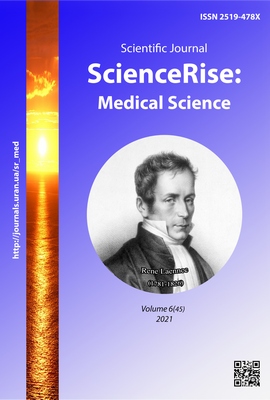Kidney`s functional state assessment when using different regimens of intraoperative fluid therapy
DOI:
https://doi.org/10.15587/2519-4798.2021.247973Keywords:
fluid therapy, restrictive, liberal, acute kidney injury, glomerular filtration rateAbstract
The aim of the research. To study the kidneys functional state when using different regimens of intraoperative fluid therapy in high cardiac risk patients during abdominal surgery.
Materials and methods. 142 patients who underwent abdominal surgical interventions mainly for oncoproctological diseases of the gastrointestinal tract, aged over 50 years old and with a history of stable coronary heart disease were divided into four groups depending on the way of intraoperative fluid therapy, which was performed according to two regimens: restrictive (R) and liberal (L). R1 (n=36) with rate of intraoperative fluid therapy 3–5 ml/ kg/ h, R2 (n=35) patients received 5–8 ml/kg/h during surgery, L1 (n=35) with intraoperative fluid rate of 8–11 ml/kg/h and L2 (n=36) – more than 11 ml/kg/h intraoperatively. The study of the functional state of the kidneys included the determination of such indicators as urea, creatinine, diuresis, the degree of AKI according to KDIGO in two stages of the study – before surgery and 18–24 hours after.
Results. The greatest tendency to develop acute kidney injury was observed in R1 subgroup with a restrictive intraoperative fluid therapy regimen, and the smallest in L1 subgroup with a relatively liberal regimen. The R2 and L2 subgroups took an intermediate place in the number of renal complications. A high tendency to develop renal dysfunction in patients of R1 subgroup was associated with circulatory hypokinesia and a moderate decrease of renal perfusion.
Conclusions. The study found that restriction of infusion in R1 subgroup contributed to the development of renal dysfunction in almost half of the patients. First of all it was associated with a decrease of GFR in conditions of circulatory hypokinesia, which is larger in R1 subgroup and amounted to about 35 %. The safest regimens of intraoperative fluid therapy in relation to renal function in the perioperative period were relatively liberal (subgroup L1) and relatively restrictive (subgroup R2), which provided the least number of complications in patients
References
- Kim, B. R., Yoon, S., Song, G. Y., Lee, S., Bahk, J. H., Nam, K. (2021). The impact of total intravenous anesthesia versus inhalation anesthesia on acute kidney injury after major abdominal surgery: a propensity score analysis. Journal of Anesthesia, 35 (1), 112–121. doi: https://doi.org/10.1007/s00540-020-02882-9
- Nishimoto, M., Murashima, M., Kokubu, M., Matsui, M., Eriguchi, M., Samejima. et. al. (2021). External Validation of a Prediction Model for Acute Kidney Injury Following Noncardiac Surgery. JAMA Network Open, 4 (10). doi: https://doi.org/10.1001/jamanetworkopen.2021.27362
- Miller, T. E., Mythen, M., Shaw, A. D., Hwang, S., Shenoy, A. V., Bershad, M. et al. (2021). Association between perioperative fluid management and patient outcomes: a multicentre retrospective study. British Journal of Anaesthesia, 126 (3), 720–729. doi: https://doi.org/10.1016/j.bja.2020.10.031
- Zhao, B. C., Lei, S.H., Yang, X., Zhang, Y., Qiu, S. D., Liu, W. F. et. al. (2021). Assessment of prognostic value of intraoperative oliguria for postoperative acute kidney injury: a retrospective cohort study. British Journal of Anaesthesia, 126 (4), 799–807. doi: https://doi.org/10.1016/j.bja.2020.11.018
- Guangyu, Y., Jingfeng, L., Xing, L., Hong, Y., Yao, L. (2021). Cardio- and Cerebrovascular Outcomes of Postoperative Acute Kidney Injury in Noncardiac Surgical Patients With Hypertension. Frontiers in Pharmacology, 12. doi: https://doi.org/10.3389/fphar.2021.696456
- Yunos, N. M., Bellomo, R., Glassford, N., Sutcliffe, H., Lam, Q., Bailey, M. (2014). Chloride-liberal vs. chloride-restrictive intravenous fluid administration and acute kidney injury: an extended analysis. Intensive Care Medicine, 41 (2), 257–264. doi: https://doi.org/10.1007/s00134-014-3593-0
- Essber, H., Cohen, B., Artis, A. S., Leung, S. M., Maheshwari, K., Khan, M. Z. et. al. (2021). Renal injury after open versus laparoscopic non-cardiac surgery: a retrospective cohort analysis. Brazilian Journal of Anesthesiology, 71 (1), 50–57. doi: https://doi.org/10.1016/j.bjane.2020.12.008
- Kidney Disease Improving Global Outcomes (KDIGO) Acute Kidney Injury Work Group (2012). KDIGO clinical practice guideline for acute kidney injury. Kidney Int Suppl, 2 (1), 138.
- Prowle, J. R., Forni, L. G., Bell, M., Chew, M. S., Edwards, M., Grams, M. E. et. al. (2021). Postoperative acute kidney injury in adult non-cardiac surgery: joint consensus report of the Acute Disease Quality Initiative and PeriOperative Quality Initiative. Nature Reviews Nephrology, 17 (9), 605–618. doi: https://doi.org/10.1038/s41581-021-00418-2
- Park, S., Cho, H., Park, S., Lee, S., Kim, K., Yoon, H. J. et. al. (2018). Simple Postoperative AKI Risk (SPARK) Classification before Noncardiac Surgery: A Prediction Index Development Study with External Validation. Journal of the American Society of Nephrology, 30 (1), 170–181. doi: https://doi.org/10.1681/asn.2018070757
- Meersch, M., Schmidt, C., Zarbock, A. (2017). Perioperative Acute Kidney Injury. Anesthesia Analgesia, 125 (4), 1223–1232. doi: https://doi.org/10.1213/ane.0000000000002369
Downloads
Published
How to Cite
Issue
Section
License
Copyright (c) 2021 Yanina Morozova, Aleksandr Pavlov

This work is licensed under a Creative Commons Attribution 4.0 International License.
Our journal abides by the Creative Commons CC BY copyright rights and permissions for open access journals.
Authors, who are published in this journal, agree to the following conditions:
1. The authors reserve the right to authorship of the work and pass the first publication right of this work to the journal under the terms of a Creative Commons CC BY, which allows others to freely distribute the published research with the obligatory reference to the authors of the original work and the first publication of the work in this journal.
2. The authors have the right to conclude separate supplement agreements that relate to non-exclusive work distribution in the form in which it has been published by the journal (for example, to upload the work to the online storage of the journal or publish it as part of a monograph), provided that the reference to the first publication of the work in this journal is included.









